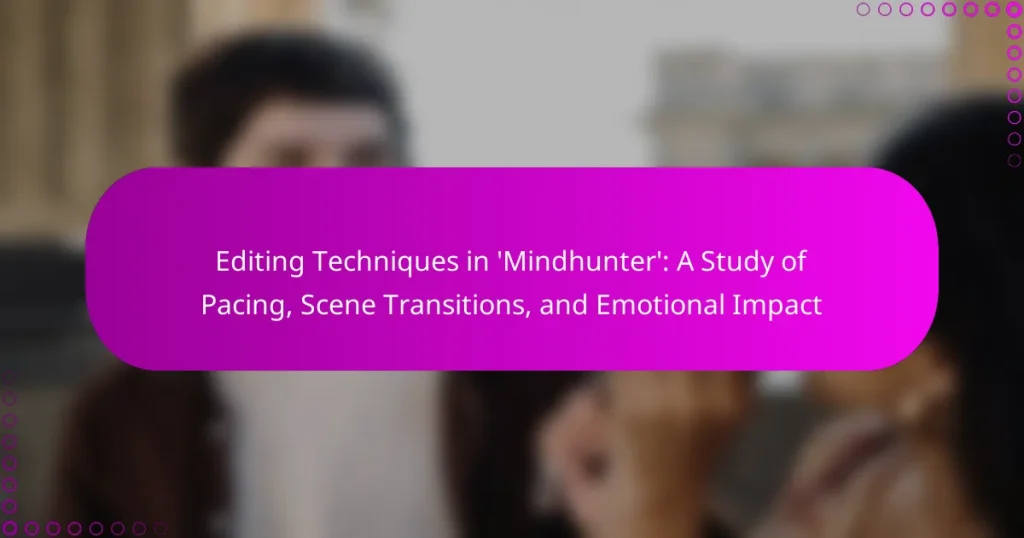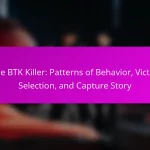The article focuses on the editing techniques utilized in the series ‘Mindhunter’, highlighting key methods such as cross-cutting, match cuts, and slow pacing. It examines how these techniques enhance character development and contribute to the psychological atmosphere of the narrative. By analyzing the impact of pacing, scene transitions, and emotional depth, the article provides insights into how editing shapes viewer engagement and understanding of characters’ internal conflicts. Best practices for evaluating these editing techniques are also outlined, offering a structured approach to analyzing their effectiveness within the series.
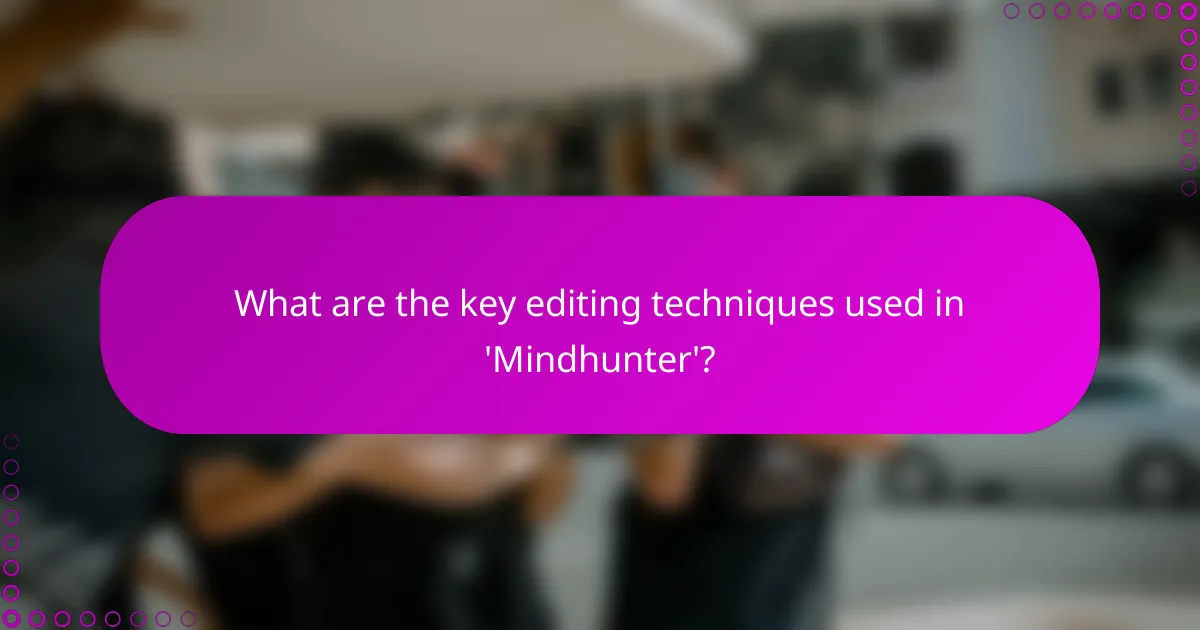
What are the key editing techniques used in ‘Mindhunter’?
The key editing techniques used in ‘Mindhunter’ include cross-cutting, match cuts, and slow pacing. Cross-cutting creates tension by juxtaposing different scenes and timelines. This technique enhances the narrative by linking characters’ experiences. Match cuts seamlessly transition between scenes, maintaining visual continuity. Slow pacing allows for character development and emotional depth. These techniques contribute to the show’s psychological atmosphere. The editing style supports the storytelling and engages the audience effectively.
How does pacing influence the storytelling in ‘Mindhunter’?
Pacing significantly influences the storytelling in ‘Mindhunter’ by controlling the rhythm and tension of the narrative. The series employs slow pacing to build suspense during interviews with serial killers. This deliberate tempo allows viewers to absorb the chilling details of the characters’ psyche. Quick cuts are used during moments of revelation or action, heightening emotional impact. The contrast between slow and fast pacing creates a dynamic viewing experience. This technique keeps audiences engaged and enhances the psychological depth of the story. Overall, pacing is a critical tool in shaping the narrative flow and emotional resonance in ‘Mindhunter’.
What role does rhythm play in the pacing of scenes?
Rhythm significantly influences the pacing of scenes. It dictates the flow and speed at which a narrative unfolds. A well-established rhythm can create tension or release, impacting audience engagement. In ‘Mindhunter’, rhythmic editing techniques enhance emotional responses. Quick cuts can increase urgency, while slower sequences allow for reflection. This manipulation of rhythm shapes viewers’ perceptions of time and space within scenes. For instance, a rapid succession of shots can heighten suspense, while elongated shots can deepen character development. Such rhythmic choices are essential for maintaining narrative momentum.
How do editing choices affect the tension and release in the narrative?
Editing choices significantly influence the tension and release in a narrative. Editors manipulate pacing through cuts and transitions, affecting audience engagement. Quick cuts can heighten tension by creating a sense of urgency. Conversely, longer takes allow for emotional release and reflection. The timing of edits also plays a crucial role; a well-timed cut can surprise viewers, amplifying suspense. In ‘Mindhunter’, strategic editing emphasizes character emotions and narrative stakes. For instance, scenes that juxtapose interviews with violent flashbacks create a stark contrast, enhancing tension. This technique keeps viewers on edge while providing necessary emotional pauses.
What types of scene transitions are prevalent in ‘Mindhunter’?
‘Mindhunter’ predominantly uses crossfades and cut transitions. Crossfades create a smooth blend between scenes, enhancing emotional continuity. This technique is often used during character introspection or significant moments. Cut transitions provide a more abrupt shift, emphasizing tension or urgency. These cuts often occur during interviews or intense dialogue exchanges. The combination of these transitions contributes to the show’s distinct pacing and emotional depth.
How do cuts and fades contribute to the flow of the story?
Cuts and fades shape the narrative flow by controlling pacing and emotional transitions. Cuts provide immediate shifts in time or perspective, enhancing tension and urgency. They allow the audience to experience rapid changes in action or dialogue. Fades, on the other hand, create a softer transition between scenes. They signal a passage of time or a change in emotional tone. This technique helps to establish mood and reflection. In ‘Mindhunter’, these editing choices are deliberate. They guide viewer engagement and maintain narrative coherence. Studies show that effective editing can significantly impact audience perception and emotional response.
What is the significance of cross-cutting in building suspense?
Cross-cutting is significant in building suspense as it creates tension through simultaneous storytelling. This technique juxtaposes different scenes, often contrasting actions or emotions. By shifting between multiple narratives, cross-cutting maintains viewer engagement. It builds anticipation as audiences await the resolution of each storyline. For instance, in ‘Mindhunter’, cross-cutting highlights the urgency of investigations alongside chilling interviews. This method amplifies emotional stakes, making the viewer more invested. Studies in film editing show that effective cross-cutting can enhance the perception of time and urgency, further intensifying suspense.
How does editing impact the emotional response of the audience?
Editing significantly impacts the emotional response of the audience. It shapes the narrative flow and influences pacing. Effective editing can heighten tension or create relief. For example, quick cuts can generate anxiety, while longer takes may evoke contemplation. Scene transitions also play a crucial role in emotional engagement. Smooth transitions can create a sense of continuity, while abrupt changes can jolt the viewer. Research indicates that editing techniques directly correlate with audience emotional reactions. A study by Bordwell and Thompson highlights how pacing manipulates viewer engagement and emotional investment.
What techniques are used to evoke empathy for characters?
Techniques used to evoke empathy for characters include backstory development, visual storytelling, and emotional dialogue. Backstory development provides context for a character’s actions. This allows viewers to understand motivations and struggles. Visual storytelling employs close-up shots to capture [censured] expressions. This technique enhances emotional connection with the audience. Emotional dialogue reveals characters’ vulnerabilities and aspirations. It creates relatable moments that resonate with viewers. Additionally, music and sound design can amplify emotional responses. These elements work together to create a deeper understanding of characters’ experiences.
How does the timing of cuts affect emotional intensity?
The timing of cuts significantly influences emotional intensity in film editing. Precise cuts can heighten tension or evoke specific emotional responses. For example, rapid cuts during a climactic scene can create urgency and anxiety. Conversely, longer takes may foster a sense of reflection or sadness. Research indicates that editing pace directly correlates with audience engagement and emotional reaction. Studies show that viewers experience increased heart rates during fast-paced sequences, indicating heightened emotional arousal. In ‘Mindhunter’, strategic cut timing amplifies character emotions and narrative tension, enhancing viewer immersion.
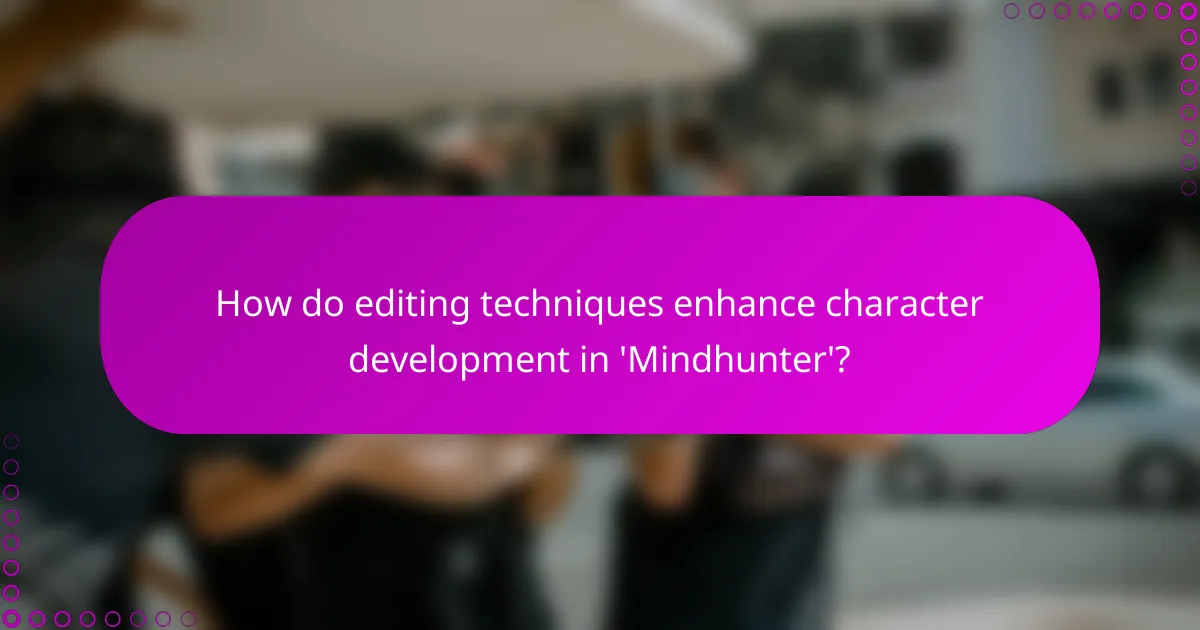
How do editing techniques enhance character development in ‘Mindhunter’?
Editing techniques in ‘Mindhunter’ enhance character development by using pacing, scene transitions, and emotional impact. The series employs rapid cuts to convey tension during interviews with serial killers. This technique reveals the psychological strain on the characters, particularly the agents. Slow-motion edits are used to emphasize critical moments, allowing viewers to delve into characters’ emotional states. Additionally, cross-cutting between scenes illustrates the contrast between the agents’ professional lives and personal struggles. This juxtaposition deepens audience understanding of their motivations. The editing style effectively mirrors the characters’ internal conflicts, making their development more relatable and profound.
What editing methods are used to highlight character motivations?
Editing methods used to highlight character motivations include close-ups, cross-cutting, and montage sequences. Close-ups focus on a character’s [censured] expressions, revealing their internal struggles and desires. Cross-cutting juxtaposes scenes to show conflicting motivations between characters, enhancing tension. Montage sequences condense time and illustrate character development, showcasing their evolving motivations. These techniques are effectively employed in ‘Mindhunter’ to deepen viewer understanding of characters’ psychological states and intentions.
How does the juxtaposition of scenes reveal character depth?
Juxtaposition of scenes reveals character depth by contrasting different emotional states and motivations. This technique allows viewers to see how characters respond to varying circumstances. For instance, a calm scene may be followed by a chaotic one, highlighting a character’s internal struggle. Such contrasts can expose vulnerabilities and strengths that may not be apparent in isolation. In “Mindhunter,” this method is used to deepen the audience’s understanding of FBI agents’ psychological states. The editing choices create a narrative rhythm that emphasizes character development. By placing scenes side by side, the filmmakers illustrate the complexity of human emotions and relationships. This approach fosters a richer, more nuanced portrayal of characters.
What is the effect of using flashbacks in character arcs?
Using flashbacks in character arcs enhances emotional depth and provides context for character motivations. Flashbacks reveal past experiences that shape a character’s present behavior. This technique allows viewers to understand the emotional weight behind a character’s decisions. In ‘Mindhunter’, flashbacks illustrate the psychological struggles of characters like Holden Ford. These moments create a connection between the audience and the character’s journey. Research indicates that flashbacks can increase audience engagement by providing backstory. The emotional resonance achieved through this technique often leads to a more impactful narrative.
How does the editing style reflect the themes of ‘Mindhunter’?
The editing style of ‘Mindhunter’ effectively highlights its themes of psychological tension and moral ambiguity. The use of slow pacing allows for deep character exploration and reflection. This pacing contrasts with quick cuts during intense scenes, emphasizing the urgency of the subject matter. Scene transitions often employ fades or dissolves, creating a dreamlike quality that mirrors the characters’ psychological states. The juxtaposition of calm dialogue scenes with abrupt, jarring edits during interviews reflects the unsettling nature of the content. Additionally, the editing reinforces the themes of obsession and the pursuit of understanding in the mind of a killer. These techniques collectively enhance the viewer’s emotional engagement with the narrative.
What editing choices emphasize the psychological aspects of the narrative?
Editing choices that emphasize the psychological aspects of the narrative include the use of jump cuts and slow-motion sequences. Jump cuts create a disjointed feeling, reflecting the characters’ mental states. Slow-motion sequences allow viewers to linger on critical moments, enhancing emotional impact. Additionally, the use of close-ups captures subtle [censured] expressions, revealing internal conflicts. The pacing is deliberately varied, with rapid transitions during tense scenes and slower pacing in reflective moments. These techniques work together to immerse the audience in the psychological tension of the narrative.
How does the pacing relate to the overarching themes of the series?
Pacing in ‘Mindhunter’ directly influences the series’ overarching themes of psychological tension and human complexity. The deliberate pacing allows for the gradual buildup of suspense, reflecting the intricate nature of criminal psychology. Slow scenes enable viewers to absorb characters’ motivations and emotional struggles. This method contrasts with faster-paced segments that heighten moments of revelation or conflict. Such variations in pacing illustrate the duality of calm introspection versus chaotic violence, reinforcing the series’ exploration of the human psyche. The careful editing choices create a rhythmic flow that mirrors the psychological tension experienced by both characters and viewers. This approach emphasizes the series’ thematic focus on the darkness within human nature and the complexities of understanding it.
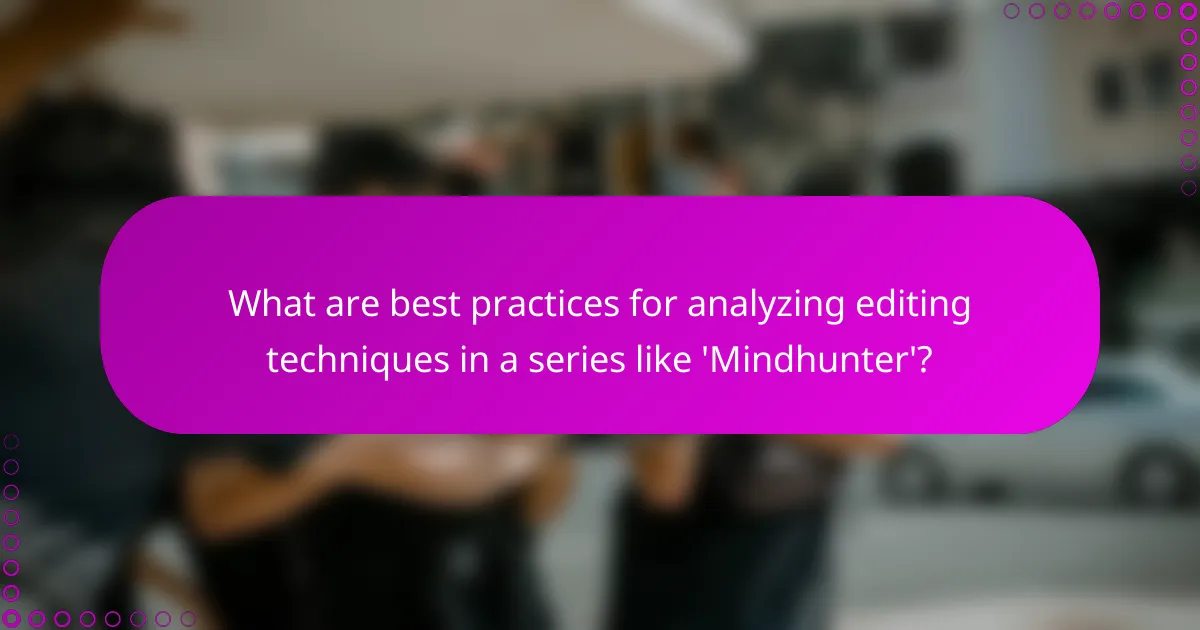
What are best practices for analyzing editing techniques in a series like ‘Mindhunter’?
Best practices for analyzing editing techniques in a series like ‘Mindhunter’ include closely examining pacing, scene transitions, and emotional impact. Start by identifying the rhythm of scenes. Analyze how the editing contributes to tension and flow. Observe the use of cuts and transitions between scenes. Note the impact of these techniques on viewer engagement. Compare specific scenes to understand variations in editing style. Use examples from the series to illustrate points. Consider the context of each editing choice and its narrative purpose. This method allows for a comprehensive understanding of the series’ editing techniques.
How can viewers effectively study the editing choices in ‘Mindhunter’?
Viewers can effectively study the editing choices in ‘Mindhunter’ by analyzing specific scenes for pacing and transitions. They should pay attention to how cuts influence the narrative flow. Observing the use of jump cuts can reveal character development and tension. Noting the timing of scene transitions is essential for understanding emotional impact. Viewers can also compare scenes to see how editing shapes viewer perception. Additionally, examining behind-the-scenes content can provide insights into the editing process. Understanding the context of each scene enhances appreciation of the choices made. This methodical approach allows for a deeper comprehension of the series’ editing techniques.
What tools or methods can enhance the analysis of editing techniques?
Software tools like Adobe Premiere Pro and Final Cut Pro can enhance the analysis of editing techniques. These platforms provide advanced features for cutting, trimming, and sequencing footage. They allow for precise control over timing and transitions. Analytical tools like Frame.io facilitate collaborative feedback and review processes. They enable editors to share work and receive input in real-time. Additionally, motion graphics software like After Effects can help analyze visual effects and transitions. These tools support the examination of pacing and emotional impact. Research shows that utilizing multiple editing software can improve workflow efficiency and creativity.
How can understanding editing deepen the viewing experience?
Understanding editing enhances the viewing experience by revealing how narrative structure and emotional tone are crafted. Editing shapes the pacing of scenes, influencing audience engagement. It allows for seamless transitions that maintain narrative flow. For example, quick cuts can heighten tension, while longer takes can evoke contemplation. Knowledge of editing techniques can help viewers appreciate the filmmaker’s choices. This appreciation can lead to a deeper emotional connection with the characters and story. Studies show that viewers who recognize editing styles are more likely to engage critically with the content. Thus, understanding editing transforms passive watching into an active, immersive experience.
Editing Techniques in ‘Mindhunter’ focuses on the examination of pacing, scene transitions, and their emotional impact within the series. Key editing techniques such as cross-cutting, match cuts, and slow pacing are analyzed for their roles in building tension and enhancing character development. The article explores how rhythm and timing of cuts affect narrative flow and audience engagement, while also highlighting the significance of scene transitions like crossfades and cuts. Additionally, it discusses best practices for analyzing these editing choices to deepen viewers’ understanding of the storytelling process in ‘Mindhunter’.
